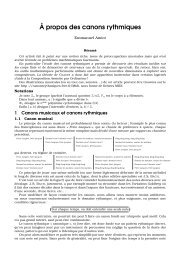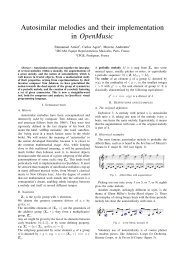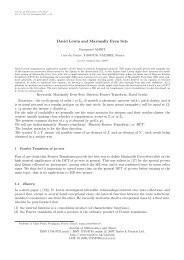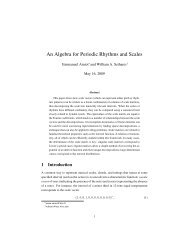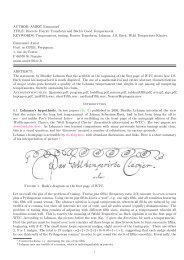Emmanuel Amiot Modèles algébriques et algorithmes pour la ...
Emmanuel Amiot Modèles algébriques et algorithmes pour la ...
Emmanuel Amiot Modèles algébriques et algorithmes pour la ...
Create successful ePaper yourself
Turn your PDF publications into a flip-book with our unique Google optimized e-Paper software.
alternative title 13<br />
For instance, the fifth f ′ = f = 7 generates both the pentatonic and the major scales, when c = 12.<br />
For, say, c = 20 and d = 8, one g<strong>et</strong>s m = 4, d ′ = 2, c ′ = 5, f ′ = 3 and the generated ME s<strong>et</strong>s with 8<br />
and 12 elements are {0, 3} ⊕ {0, 5, 10, 15} and {0, 3, 6, 9} ⊕ {0, 5, 10, 15} = {0, 3, 1, 4} ⊕ {0, 5, 10, 15}. More<br />
generally,<br />
Theorem 4.2 L<strong>et</strong> 1 < d ≤ c/2; then any given 〈c, c − d〉 ME s<strong>et</strong> contains several (exactly c ′ − 2d ′ + 1)<br />
〈c, d〉 ME s<strong>et</strong>s. In other words, any ‘small’ ME s<strong>et</strong> is contained in several trans<strong>la</strong>tes of its complement<br />
Proof A 〈c, d〉 ME s<strong>et</strong> is constructed by truncating to just d ′ consecutive values the sequence<br />
{f ′ , 2f ′ , . . . (c ′ − d ′ )f ′ } mod c ′ , which generates (adding up c ′ Zc) the given 〈c, c − d〉 ME s<strong>et</strong> A. This<br />
can be done in precisely c ′ − 2d ′ + 1 ways.<br />
From there, as seen in thm. 2.8, it suffices to add c ′ Zc to g<strong>et</strong> both whole ME s<strong>et</strong>s, since c ′ is the same<br />
for d and c − d, preserving the inclusion re<strong>la</strong>tion all the time. <br />
We would like to baptize this result Chopin’s theorem in reference to the Etude op 10 N ◦ 5 (see fig.<br />
in Supplementary II of the online version) where the right hand p<strong>la</strong>ys the pentatonic (b<strong>la</strong>ck keys only)<br />
while the left hand wanders through several keys, G f<strong>la</strong>t and D f<strong>la</strong>t major for instance. This result has<br />
been observed (especially in this pentatonic ⊂ major scale case) and commented 1 although perhaps it has<br />
not been stated and proved as a quality of all ME s<strong>et</strong>s (or, alternatively, generated scales).<br />
So David Lewin, who almost invented ME s<strong>et</strong>s as we have seen, might also have originated s<strong>et</strong>-complex<br />
Kh−theory too in one fell swoop.<br />
5 Coda<br />
We have examined the definition of the DFT of a pc-s<strong>et</strong>, according to David Lewin. Several interesting<br />
features of the pc-s<strong>et</strong> are encapsu<strong>la</strong>ted in the absolute value of this function.<br />
Following then Ian Quinn, we were led to advance an original definition of Maximally Even s<strong>et</strong>s, which<br />
appears to be geom<strong>et</strong>rical, concise, elegant, and illuminating 2 . We hope that this definition will become a<br />
productive one.<br />
Acknowledgements<br />
First of all to Ian Quinn who not only spelled out the property which makes the gist of this paper, but also<br />
drew our attention, through his comprehensive study of chords <strong>la</strong>ndscape, to the impressive advantages<br />
of the DFT of chords, and not only ME s<strong>et</strong>s and other ‘prototypes’. David C<strong>la</strong>mpitt kindly exp<strong>la</strong>ined the<br />
subtl<strong>et</strong>ies of WF scales vs ME s<strong>et</strong>s and most of the history of these fascinating notions. Equally important<br />
to the field of ‘mathemusical’ knowledge is the continued contribution of Jack Douth<strong>et</strong>t (with the <strong>la</strong>te<br />
John Clough and other partners).<br />
Several reviewers have been instrumental in bringing this paper up to the quality level of the Journal,<br />
an undomitable task for a lone writer. I would like to thank especially Dmitri Tymocsko, Robert Peck and<br />
particu<strong>la</strong>rly Thomas Noll, in that respect.<br />
References<br />
[1] <strong>Amiot</strong>, E., 2006, Une preuve élégante du théorème de Babbitt par transformée de Fourier discrète, Quadrature, 61, EDP Sciences,<br />
Paris.<br />
[2] <strong>Amiot</strong>, E., The Different Generators of A Scale, 2008, Journal of Music Theory, to be published.<br />
[3] Babbitt, M., 1955, Some Aspects of Twelve-Tone Composition, Score, 12 , 53-61.<br />
[4] Block, S. Douth<strong>et</strong>t, J.., 1994, Vector products and intervallic weighting, Journal of Music Theory , 38, 2142.<br />
1For instance in [17], 2.3: “ all secondary prototypes are Kh-re<strong>la</strong>ted to one another”, which seems to be an equivalent statement to<br />
the theorem above.<br />
2Though less general than [10] which allows all possible strictly convex measures on the unit circle to be chosen indifferently.




